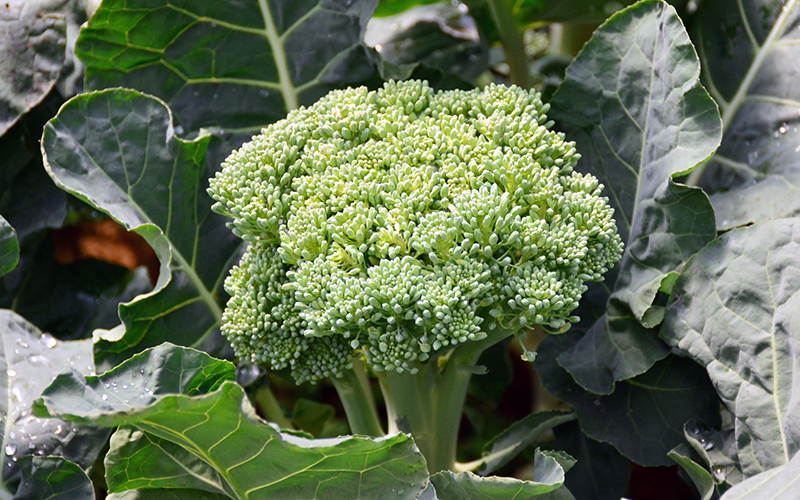
by the editors at Rodale’s Organic Life
Broccoli is a great choice for a home garden. Freshly cut broccoli heads are rich in vitamins and minerals. They’re delicious raw in salads or lightly steamed and they freeze well. If you choose a variety such as DiCicco or Waltham that produces plentiful side shoots, you can enjoy several cuttings from each plant in your garden. Broccoli raab and Chinese broccoli are fast-growing, cool-loving broccoli relatives that produce small, tender flowering shoots that you can eat—buds, stems, leaves, and all.
Planting
Broccoli prefers full sun, but partial shade can prevent plants from bolting (going to seed) in areas with warm spells. Provide a rich, well-drained soil, with plenty of compost (don’t have any? Here’s how to get Garden-Ready Compost In 30 Days).
Cool days and nights are essential once the flower heads start to form. There’s a wide range of days to maturity, so pick a cultivar that will mature before the weather in your area turns hot. Gardeners in most temperate areas can harvest both spring and fall crops. Choose a fast-maturing variety like Packman for a spring crop. In areas without ground freezes, try growing a third crop by planting a slow-maturing variety such as Marathon in winter.
If you’re planning to Start Your Own Seedlings, sow your spring crop indoors 7 to 9 weeks before the last expected frost. Seeds should germinate in 4 to 5 days. After the seeds germinate, place pots in a sunny area or under lights and maintain the temperature at 60 to 65 degrees; keep the soil moist but not wet. Whether you grow your own or buy from a local grower, to avoid premature heading, make sure seedlings are the proper size before transplanting them into the garden—about 6 inches tall, with 2 to 4 true leaves. Before transplanting, harden them off for at least a week, as described in the Transplanting entry. Set the young plants 1 to 2 inches deeper in the garden than they grew in the pots or flats. Space them 1 to 2 feet apart in rows 2 to 3 feet apart. Closer spacing will produce smaller heads. Firm the soil and water well.
Protecting young broccoli plants from temperature extremes is critical for a successful crop. A prolonged period of nights around 30 and days in the 50 to 60 degree range can produce tiny, immature heads called buttons. To prevent this, protect plants with cloches or row covers during cool weather. Unexpected warm spells can cause the heads to “rice,” or open too soon.
For fall crops, you can start seedlings indoors or sow seeds directly in the ground in July or August. In mild-winter climates, plant in the late fall for a spring harvest.
Growing Guidelines
The trick to producing good broccoli is to keep it growing steadily. Two to three weeks after transplanting, topdress with Compost Tea or side-dress with blood meal or fish emulsion, and water deeply. Repeat monthly until a week before harvesting the flower head. This regimen also encourages large and tender side shoots, which you can harvest until hot weather or a heavy ground freeze ends the broccoli season.
Cultivate around young plants to get rid of weeds and keep the soil loose. When daytime temperatures exceed 75, put down a thick layer of organic mulch to cool the soil and conserve moisture. Broccoli needs 1 to 1½ inches of water a week. A lack of water will result in tough stems, so soak plants extra well during dry spells. A fall crop of broccoli need steady (but slightly less) water.
Problems
Of all cabbage-family plants, broccoli is often the least affected by pests, and fall crops tend to have fewer problems than spring ones. Possible pests include aphids, cabbage loopers, imported cabbageworms, cabbage maggots, cutworms, and flea beetles.
Other pests include slugs, mites, and harlequin bugs. Slugs chew holes in plant leaves; see the Slugs and Snails entry for controls. Mites are tiny red or black pests; their feeding causes yellow stippling on the leaves. Knock them off the plant with a strong blast of water, or spray with insecticidal soap. Control harlequin bugs—black insects with red markings—by hand picking or applying soap spray.
Diseases are seldom a problem. Black leg produces dark spots on leaves and stems. Symptoms of black rot include yellowing leaves and dark, foul-smelling veins. Prevent these diseases with good cultivation and crop rotation. In case of club root, which shows up as weak, yellowed plants with deformed roots, destroy the infected plants. Plant your next crop in another part of the garden, and before planting, apply lime to boost soil pH to about 7.0.
Leaf spot shows up as enlarging, water-soaked spots that turn brown or purplish gray. Fusarium wilt, also known as yellows, causes lower leaves to turn yellow and drop off and makes broccoli heads stunted and bitter. Destroy plants afflicted with leaf spot or Fusarium wilt to prevent these diseases from spreading.
Harvesting
Harvest before the florets start to open and turn yellow. Cut just below the point where the stems begin to separate. Once you’ve harvested the main head, tender side shoots will form in the leaf axils all along the lower stalk. Keep cutting, and broccoli will keep producing until the weather turns too hot or too cold. Can, freeze, or pickle broccoli, or keep it refrigerated for up to 2 weeks. Green cabbage loopers and imported cabbageworms often go unnoticed on harvested heads and can end up in your cooked broccoli. To prevent this, drive them out by soaking the heads in warm water with a little vinegar added for 15 minutes before cooking.
This story was previously published on RodalesOrganicLife.com




No comments yet.